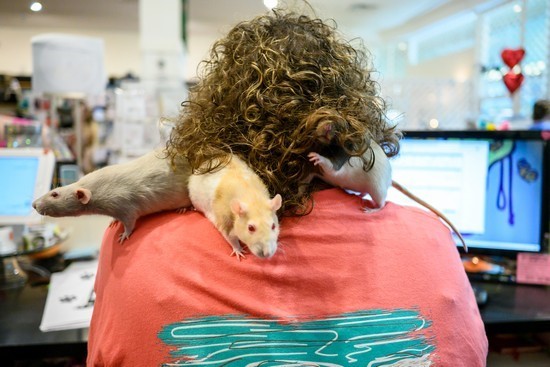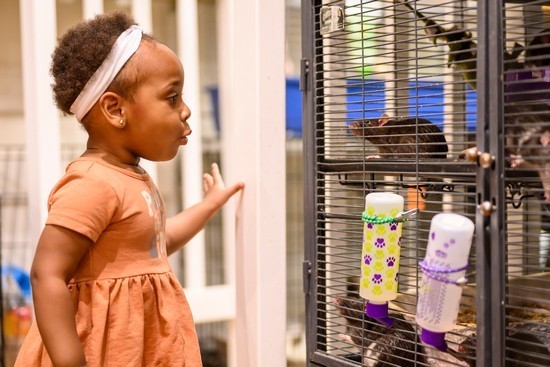When Alia Mahmud visited Westfield Annapolis Mall in
February 2022, she did not go to buy clothes, or to watch a movie or to even
meet up with her girlfriends. She was looking for rats.
اضافة اعلان
Rats at the mallA week earlier, Mahmud saw a post online about a pack of
rodents at the SPCA of Anne Arundel County, whose shelter opened an outpost at
the mall in September 2020.
When she arrived at the new location and approached the rat
enclosure, she saw Snoofles, Algernon and Ikit, five-month-old sisters who
perked up and pressed their pink noses through their crate to get a better look
at Mahmud and her boyfriend.
“They kind of ran up to us and said hi,” said Mahmud, 32, a
school therapist in Alexandria, Virginia. “They melted our hearts with how
little, affectionate and outgoing they were from the beginning.”
But it wasn’t until a meet-and-greet days later when Mahmud
finally decided to take them home, after Snoofles proceeded to run down her
shirt.
“At that point, I was like, well all right, I guess they’ve
chosen,” Mahmud said.
Among thousands
Snoofles, Algernon, and Ikit are just some of the thousands
of pets that have been adopted from animal shelters sprouting up in malls
across the US in the past three years.
A growing number of shopping centers are offering animal
rescue groups empty storefronts for free or at a significant discount,
sometimes as much as up to 90 percent.

According to Shelter
Animals Count, an animal welfare national database, shelters reported that
intakes increased 4 percent in 2022, leaving them overburdened with animals
that were once hard to obtain during quarantine.
With collaborations like the one between the SPCA and
Westfield Annapolis gaining popularity, malls and animal havens are hoping to
attract more pet owners and customers to these retail spaces that were already
struggling before the pandemic forced temporary closures.
Morgan McLoud, the marketing director at Westfield
Annapolis, came up with the idea to lease retail spaces to animal shelters at a
reduced rate in January 2020, after she saw dozens of people line up to pay $25
to visit a crowded cat cafe in Washington.
Paws at the mallWithin days, she reached out to Kelly Brown, president of
the SPCA of Anne Arundel County, who suggested using one of the mall’s empty
storefronts as an extension of the organization’s main shelter. The new
outpost, Paws at the Mall, opened eight months later. Since then, Paws has seen
the number of adoptions rise to 608 in 2021, from 131 in 2019, finding homes
for hundreds of cats, guinea pigs, rabbits, hamsters and even some hedgehogs
and hermit crabs.
Developers had been thinking of ways to re-imagine the mall
long before the pandemic, said Alexandra Lange, the author of “Meet Me by the
Fountain,” which explores the history and future of American malls.
Malls had their golden age in the 1990s. Some had
architecture that re-created quaint towns with cobblestone streets. Others
offered photo shoots with Santa Claus, carousel rides and even life-size
dinosaur-themed exhibits. Teenagers would often spend their leisure time lounging
in the food court, riding escalators and loitering in Abercrombie & Fitch
stores.
In-store shopping, bye-byeBut then came the rise of the internet in the early 2000s.
The prevalence of online shopping and the subsequent decline in demand for
physical retail space had malls struggling to reinvent the shopping experience.

Moving animal shelters into empty storefronts is just the
latest effort by shopping centers to try to lure more customers in, Lange said.
“Malls got so big and so commercial and so nationally
franchised that they kind of forgot about that low-hanging fruit,” Lange said,
referring to more community-based experiences. “So going back to that place
that’s closer to their original community, neighborhood spirit seems like a
totally reasonable idea.”
For animal shelters, the move has been widely successful.
L.A. Love & Leashes, an organization in Los Angeles that
picks animals up from the city’s six shelters every morning and displays them
at its mall storefront before returning unadopted pets in the evening, has
found homes for more than 3,000 pets since relocating into a shopping center in
2021, more than doubling yearly adoption rates.
In Illinois, Orphans of the Storm has found homes for more
than 200 cats and dogs out of their two mall locations in Vernon Hills and
Northbrook since opening in 2021, tripling its annual adoption rate. And Hop on
Home, one of two animal shelters in Wilton Mall, in Saratoga Springs, New York,
has found homes for 354 bunnies since opening a store at the shopping center in
2022, tripling its annual adoption rate.
“When people walk by and they see kittens in a window, it
automatically draws them into the store,” said Tammy Davis, the executive
director of the Washington County Johnson City Animal Shelter in Tennessee.

The shelter opened an outpost in February 2021 after the
Mall at Johnson City offered to lease them an annex at a slightly reduced rate,
she said. “Having an off-site location, especially in a high-traffic mall area,
we were able to reach people that we may have never reached before.”
Jonquay Armon, 50, a client service adviser in Round Lake,
Illinois, said she found shelters “too depressing,” and would have never gone
to one had it not been for these new mall outposts. Armon was rushing to a hair
appointment at Hawthorn Mall when she saw Farley, a 10-year-old pit bull and
mastiff mix in the storefront of Orphans of the Storm. She took him home a week
later.
A socially active environment like a window display also
provides an opportunity for temperamental animals to become better acclimated
with humans, increasing their chances of being adopted. Shadow, a black pit
bull mix, sat in the Los Angeles city shelter of L.A. Love & Leashes for
seven months before being adopted 10 days after he was showcased at its mall
location.
“Sometimes great animals will get overlooked because they
are hiding in the back of the kennel, because they’re super nervous,” said
Lauren Kay, a volunteer coordinator at L.A. Love & Leashes.
With all the furry encounters, McLoud, the marketing
director, said that Westfield Annapolis Mall had experienced a 10 percent
increase in foot traffic in Paws’ wing since they opened, which has translated
into more people and spending in other stores.
“The evolution of malls is changing,” McLoud said. “I think
everyone really realizes that. I think what makes us so unique and special is
the fact that we are really adapting with this evolution.”
Read more Odd and Bizarre
Jordan News

